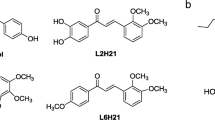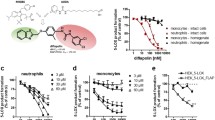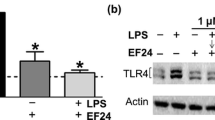Abstract
Triggering receptors expressed on myeloid cell-1 (TREM-1) is a superimmunoglobulin receptor expressed on myeloid cells. TREM-1 amplifies the inflammatory response. Epoxyeicosatrienoic acids (EETs), the metabolites of arachidonic acid derived from the cytochrome P450 enzyme, have anti-inflammatory properties. However, the effects of EETs on TREM-1 expression under inflammatory stimulation remain unclear. Therefore, inhibition of soluble epoxide hydrolase (sEH) with a highly selective inhibitor [1-trifluoromethoxyphenyl-3-(1-propionylpiperidin-4-yl) urea, TPPU] was used to stabilize EETs. LPS was intratracheally injected into mice to induce pulmonary inflammation, after TPPU treatment for 3 h. Histological examination showed TPPU treatment-alleviated LPS-induced pulmonary inflammation. TPPU decreased TREM-1 expression, but not DAP12 or MyD88 expression. Murine peritoneal macrophages were challenged with LPS in vitro. We found that TPPU reduced LPS-induced TREM-1 expression in a dose-dependent manner, but not DAP12 or MyD88 expression. TPPU also decreased downstream signal from TREM-1, reducing pro-inflammatory cytokine TNF-α and IL-1β mRNA expression. Furthermore, TPPU treatment inhibited IkB degradation in vivo and in vitro. Our results indicate that the inhibition of sEH suppresses LPS-induced TREM-1 expression and inflammation via inhibiting NF-kB activation in murine macrophage.





Similar content being viewed by others
REFERENCES
Yong, Y. K., E. M. Shankar, A. Solomon, T. Spelman, C. K. Fairley, J. Elliott, et al. 2016. Polymorphisms in the CD14 and TLR4 genes independently predict CD4+ T-cell recovery in HIV-infected individuals on antiretroviral therapy. AIDS.
Aghagolzadeh, P., M. Bachtler, R. Bijarnia, C. Jackson, E. R. Smith, A. Odermatt, et al. 2016. Calcification of vascular smooth muscle cells is induced by secondary calciprotein particles and enhanced by tumor necrosis factor-alpha. Atherosclerosis.
Minutti, C. M., B. Garcia-Fojeda, A. Saenz, M. de Las Casas-Engel, R. Guillamat-Prats, A. de Lorenzo, et al. 2016. Surfactant Protein A Prevents IFN-gamma/IFN-gamma Receptor Interaction and Attenuates Classical Activation of Human Alveolar Macrophages. J Immunol.
Bouchon, A., J. Dietrich, and M. Colonna. 2000. Cutting edge: inflammatory responses can be triggered by TREM-1, a novel receptor expressed on neutrophils and monocytes. Journal of Immunology 164: 4991–4995.
Arts, R.J., L.A. Joosten, J.W. van der Meer, and M.G. Netea. 2013. TREM-1: intracellular signaling pathways and interaction with pattern recognition receptors. Journal of Leukocyte Biology 93: 209–215.
Fan, D., X. He, Y. Bian, Q. Guo, K. Zheng, Y. Zhao, et al. 2016. Triptolide modulates TREM-1 signal pathway to inhibit the inflammatory response in rheumatoid arthritis. International Journal of Molecular Sciences 17.
Rigo, I., L. McMahon, P. Dhawan, S. Christakos, S. Yim, L.K. Ryan, et al. 2012. Induction of triggering receptor expressed on myeloid cells (TREM-1) in airway epithelial cells by 1,25(OH)(2) vitamin D(3). Innate Immunity 18: 250–257.
Willi, M., G.N. Belibasakis, and N. Bostanci. 2014. Expression and regulation of triggering receptor expressed on myeloid cells 1 in periodontal diseases. Clinical and Experimental Immunology 178: 190–200.
Jeremie, L., B. Amir, D. Marc, and G. Sebastien. 2015. The triggering receptor expressed on myeloid cells-1: a new player during acute myocardial infarction. Pharmacological Research 100: 261–265.
Genua, M., S. Rutella, C. Correale, and S. Danese. 2014. The triggering receptor expressed on myeloid cells (TREM) in inflammatory bowel disease pathogenesis. Journal of Translational Medicine 12: 293.
Yuan, Z., M. Syed, D. Panchal, M. Joo, C. Bedi, S. Lim, et al. 2016. TREM-1-accentuated lung injury via miR-155 is inhibited by LP17 nanomedicine. American Journal of Physiology - Lung Cellular and Molecular Physiology 310: L426–L438.
Zhong, J., W. Huang, Q. Deng, M. Wu, H. Jiang, X. Lin, et al. 2016. Inhibition of TREM-1 and Dectin-1 alleviates the severity of fungal keratitis by modulating innate immune responses. PLoS One 11: e0150114.
Sun, G.Y., C.X. Guan, Y. Zhou, Y.P. Liu, S.F. Li, H.F. Zhou, et al. 2011. Vasoactive intestinal peptide re-balances TREM-1/TREM-2 ratio in acute lung injury. Regulatory Peptides 167: 56–64.
Zheng, H., C.A. Heiderscheidt, M. Joo, X. Gao, N. Knezevic, D. Mehta, et al. 2010. MYD88-dependent and -independent activation of TREM-1 via specific TLR ligands. European Journal of Immunology 40: 162–171.
Huang, H., J. Weng, and M. H. Wang. 2016. EETs/sEH in diabetes and obesity-induced cardiovascular diseases. Prostaglandins Other Lipid Mediat.
Pillarisetti, S., and I. Khanna. 2015. A multimodal disease modifying approach to treat neuropathic pain–inhibition of soluble epoxide hydrolase (sEH). Drug Discovery Today 20: 1382–1390.
Zhou, Y., G.Y. Sun, T. Liu, J.X. Duan, H.F. Zhou, K.S. Lee, et al. 2016. Soluble epoxide hydrolase inhibitor 1-trifluoromethoxyphenyl-3- (1-propionylpiperidin-4-yl) urea attenuates bleomycin-induced pulmonary fibrosis in mice. Cell and Tissue Research 363: 399–409.
Ren, Q., M. Ma, T. Ishima, C. Morisseau, J. Yang, K.M. Wagner, et al. 2016. Gene deficiency and pharmacological inhibition of soluble epoxide hydrolase confers resilience to repeated social defeat stress. Proceedings of the National Academy of Sciences of the United States of America 113: E1944–E1952.
Bettaieb, A., S. Chahed, S. Bachaalany, S. Griffey, B.D. Hammock, and F.G. Haj. 2015. Soluble epoxide hydrolase pharmacological inhibition ameliorates experimental acute pancreatitis in mice. Molecular Pharmacology 88: 281–290.
Lopez-Vicario, C., J. Alcaraz-Quiles, V. Garcia-Alonso, B. Rius, S.H. Hwang, E. Titos, et al. 2015. Inhibition of soluble epoxide hydrolase modulates inflammation and autophagy in obese adipose tissue and liver: role for omega-3 epoxides. Proceedings of the National Academy of Sciences of the United States of America 112: 536–541.
Qi, D., J. He, D. Wang, W. Deng, Y. Zhao, Y. Ye, et al. 2014. 17beta-estradiol suppresses lipopolysaccharide-induced acute lung injury through PI3K/Akt/SGK1 mediated up-regulation of epithelial sodium channel (ENaC) in vivo and in vitro. Respiratory Research 15: 159.
Park, J. S., M. Y. Park, Y. J. Cho, J. H. Lee, C. G. Yoo, C. T. Lee, et al. 2016. Anti-inflammatory effect of erdosteine in lipopolysaccharide-stimulated RAW 264.7 cells. Inflammation.
Peng, L., Y. Zhou, L. Dong, R.Q. Chen, G.Y. Sun, T. Liu, et al. 2016. TGF-beta1 upregulates the expression of triggering receptor expressed on myeloid cells 1 in murine lungs. Science Reports 6: 18946.
Tao, F., L. Peng, J. Li, Y. Shao, L. Deng, and H. Yao. 2013. Association of serum myeloid cells of soluble triggering receptor-1 level with myocardial dysfunction in patients with severe sepsis. Mediators of Inflammation 2013: 819246.
Bostanci, N., V.O. Ozturk, G. Emingil, and G.N. Belibasakis. 2013. Elevated oral and systemic levels of soluble triggering receptor expressed on myeloid cells-1 (sTREM-1) in periodontitis. Journal of Dental Research 92: 161–165.
Murakami, Y., H. Kohsaka, H. Kitasato, and T. Akahoshi. 2007. Lipopolysaccharide-induced up-regulation of triggering receptor expressed on myeloid cells-1 expression on macrophages is regulated by endogenous prostaglandin E2. Journal of Immunology 178: 1144–1150.
Rao, V.H., V. Rai, S. Stoupa, S. Subramanian, and D.K. Agrawal. 2016. Tumor necrosis factor-alpha regulates triggering receptor expressed on myeloid cells-1-dependent matrix metalloproteinases in the carotid plaques of symptomatic patients with carotid stenosis. Atherosclerosis 248: 160–169.
Kim, T.H., B. Lee, E. Kwon, S.J. Choi, Y.H. Lee, G.G. Song, et al. 2013. Regulation of TREM-1 expression by 1,25-dihydroxyvitamin D3 in human monocytes/macrophages. Immunology Letters 154: 80–85.
Morisseau, C., and B.D. Hammock. 2013. Impact of soluble epoxide hydrolase and epoxyeicosanoids on human health. Annual Review of Pharmacology and Toxicology 53: 37–58.
Tsai, H.J., S.H. Hwang, C. Morisseau, J. Yang, P.D. Jones, T. Kasagami, et al. 2010. Pharmacokinetic screening of soluble epoxide hydrolase inhibitors in dogs. European Journal of Pharmaceutical Sciences 40: 222–238.
Chen, D., R. Whitcomb, E. MacIntyre, V. Tran, Z.N. Do, J. Sabry, et al. 2012. Pharmacokinetics and pharmacodynamics of AR9281, an inhibitor of soluble epoxide hydrolase, in single- and multiple-dose studies in healthy human subjects. Journal of Clinical Pharmacology 52: 319–328.
Acknowledgments
This work was supported by the National Natural Science Foundation of China (No. 81500065, 81670014), the Specialized Research Fund for the Doctoral Program of Higher Education of China (20130162110052), High School Innovation Fund of Hunan province (15K140), and the Open-End Fund for the Valuable and Precision Instruments of Central South University (CSUCZ201632).
Author Contributions
Conceived and designed the experiments: CXG LD YZ. Performed the experiments: LD YZ TL PL. Analyzed the data: LD JXD JZ YZ. Contributed reagents/materials/analysis tools: YZ BDH CXG. Wrote the paper: LD YZ CXG. Critically reviewed the manuscript: BDH CXG.
Author information
Authors and Affiliations
Corresponding author
Ethics declarations
Conflict of Interest
The authors declare no conflict of interest.
ELECTRONIC SUPPLEMENTARY MATERIAL
Below is the link to the electronic supplementary material.
Supplementary Table 1
(DOC 30 kb)
Rights and permissions
About this article
Cite this article
Dong, L., Zhou, Y., Zhu, ZQ. et al. Soluble Epoxide Hydrolase Inhibitor Suppresses the Expression of Triggering Receptor Expressed on Myeloid Cells-1 by Inhibiting NF-kB Activation in Murine Macrophage. Inflammation 40, 13–20 (2017). https://doi.org/10.1007/s10753-016-0448-6
Published:
Issue Date:
DOI: https://doi.org/10.1007/s10753-016-0448-6




